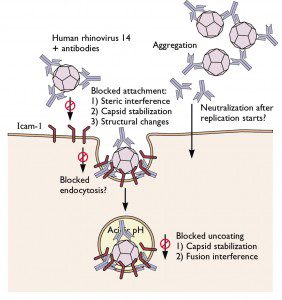

A cytoplasmic protein called TRIM21 (tripartite motif-containing 21) was recently found to bind with high affinity to the conserved regions of antibody molecules. The presence of this activity in many mammalian species suggested that there could be ways that antibodies operate within cells. This possibility was studied by using adenovirus infection of cultured cells. When adenovirions were mixed with neutralizing antibodies and added to cells, the antibody-coated particles entered the cytoplasm where they became associated with TRIM21. This behavior was observed when several different adenovirus antibodies were used, suggesting that it is not an unusual property of one type of antibody.
By definition, neutralizing antibodies reduce viral infectivity. When levels of cellular TRIM21 protein were depleted, neutralizing antibodies had little effect on adenovirus infectivity. This effect was found in several cell lines, using three different anti-adenovirus antibodies, and requires the antibody Fc domain. These observations show that adenovirus neutralization by antibodies occurs in the cell cytoplasm, and is dependent upon the binding of antibodies to TRIM21 protein.
How does the interaction of TRIM21 with antibodies bound to adenovirus neutralize viral infectivity? TRIM21 is known to target proteins for degradation by linking them to a small protein called ubiquitin, which labels them for elimination. Cells have two different pathways for degrading ubiquitinated proteins: autophagy and the proteasome. Neutralization of antibody-coated adenovirus was not affected by an inhibitor of autophagy, but was blocked by a proteasome inhibitor. Consistent with this observation, antibody-coated adenovirions in the cell cytoplasm contained both TRIM21 and ubiquitin. Such virions are rapidly degraded, destroying their infectivity.
When antibodies were introduced in uninfected cells, they still associated with TRIM21 protein. This observation means that a virus particle is not needed for the interaction of TRIM21 with antibody. The importance of this finding is that it is possible that other viruses are neutralized by a TRIM21-dependent mechanism. Answering this question could have practical value, because stimulation of TRIM21 immunity might be an important property of effective vaccines.
TRIM21 is an example of a protein that bridges the innate and adaptive immune responses. It is induced by interferons, which are produced early in infection as foreign molecules are detected by the innate immune system. Furthermore, TRIM21 assists in viral neutralization by binding to antibodies, which are products of the adaptive immune response. As would be expected, antibody neutralization of adenovirus is more efficient when cells are treated with interferon.
The participation of cytoplasmic TRIM21 in antibody-mediated virus neutralization might explain a variety of previously unexplained observations. These include:
- There is a linear-log relationship between antibody dilution and neutralization of adenovirus, and longer incubation does not result in more neutralization
- Antibody neutralization of poliovirus is observed even when antibodies are added after attachment of virions to cells
- A single IgG antibody molecule is enough to neutralize poliovirus and adenovirus infectivity
- 5-6 IgG molecules are enough to neutralize rhinovirus
- Intact antibody molecules are more effective at neutralizing viruses than those which have been cleaved to produce Fab and Fc fragments
It has always been difficult to understand how just a few antibody molecules can neutralize viral infectivity. The TRIM21 dependent mechanism provides the first plausible mechanism.
An important issue that is not addressed by these studies is the relationship between viral entry and TRIM21 mediated neutralization. Adenovirus is taken into the cell by endocytosis, and then released into the cytoplasm as a partially disassembled particle which docks onto the nuclear pore complex, leading to entry of DNA into the nucleus. Does TRIM21 accompany the virion throughout the endocytic process, targeting the capsid to the proteasome after it is released from the endosome? If TRIM21 were shown to be involved in neutralization of poliovirus, it would not be consistent with the observation that poliovirions do not exit endosomes – the viral RNA is simply translocated across the endosome membrane.
TRIM21-dependent antibody neutralization of viruses is a fascinating new mechanism that could apply to a wide range of viruses. But a number of questions must be answered before it enters the virology textbooks.
Mallery DL, McEwan WA, Bidgood SR, Towers GJ, Johnson CM, & James LC (2010). Antibodies mediate intracellular immunity through tripartite motif-containing 21 (TRIM21). Proceedings of the National Academy of Sciences of the United States of America PMID: 21045130

Pingback: Tweets that mention Antibodies neutralize viral infectivity inside cells -- Topsy.com
j ai un exposé sur les virus satellites
j espère que quelqu’un de ma idée pour faire ca
merci a tous
How big is TRIM 21?
Pingback: Biomedicine – Part 11: Curing in the 21st Century – Influenza and the Common Cold « 21st Century Tech Blog